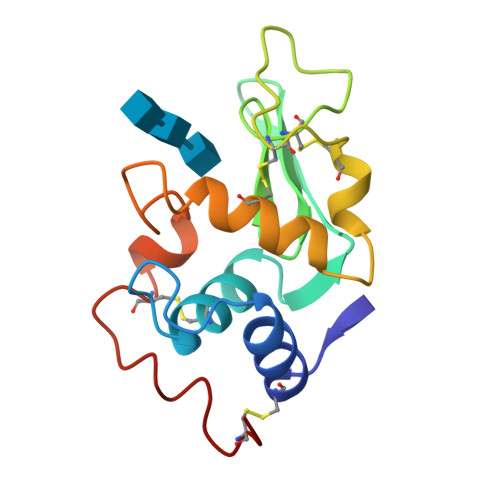Refinement of an enzyme complex with inhibitor bound at partial occupancy. Hen egg-white lysozyme and tri-N-acetylchitotriose at 1.75 A resolution.
Cheetham, J.C., Artymiuk, P.J., Phillips, D.C.(1992) J Mol Biology 224: 613-628
- PubMed: 1569548
- DOI: https://doi.org/10.1016/0022-2836(92)90548-x
- Primary Citation of Related Structures:
1HEW - PubMed Abstract:
The structure of the tri-N-acetylchitotriose inhibitor complex of hen egg-white lysozyme has been refined at 1.75 A resolution, using data collected from a complex crystal with ligand bound at less than full occupancy. To determine the exact value of the inhibitor occupancy, a model comprising unliganded and sugar-bound protein molecules was generated and refined against the 1.75 A data, using a modified version of the Hendrickson & Konnert least-squares procedure. The crystallographic R-factor for the model was found to fall to a minimum at 55% bound sugar. Conventional refinement assuming unit occupancy was found to yield incorrect thermal and positional parameters. Application of the same refinement procedures to an earlier 2.0 A data set, collected independently on different complex crystals by Blake et al. gave less consistent results than the 1.75 A refinement. From an analysis of the high resolution structure a detailed picture of the protein-carbohydrate interactions in the non-productive complex has emerged, together with the conformation and mobility changes that accompany ligand binding. The specificity of interaction between the protein and inhibitor, bound in subsites A to C of the active site, is seen to be generated primarily by an extensive network of hydrogen bonds, both to the protein itself and to bound solvent molecules. The latter also play an important role in maintaining the structural integrity of the active site cleft in the apo-protein.
Organizational Affiliation:
Laboratory of Molecular Biophysics, University of Oxford, England.


















